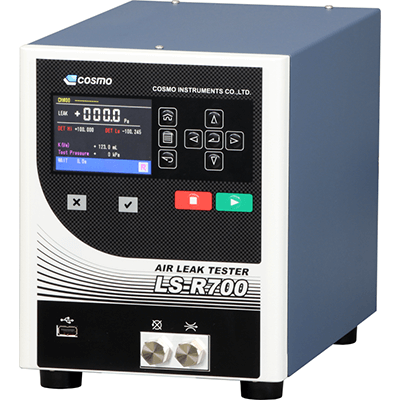What Is an Air Leak Tester?
 An air leak tester is a device to detect air leaks from inside an object.
An air leak tester is a device to detect air leaks from inside an object.
Leak testing is performed by pressurizing or depressurizing the inside of an object and detecting the pressure with various methods, such as direct pressure or differential pressure. The appropriate type of air leak tester depends on the shape of the object and whether it contains anything other than air or water.
Unlike a simple leak test using soapy water, an air leak tester can accurately detect the location and amount of leaks.
Uses of Air Leak Tester
Air leak testers can be used not only to simply check for leaks, but also to quantitatively determine the amount of leakage and to automate inspections.
Specific leak inspections include the following:
- Fittings of cooling water piping.
- Regulators of gas stoves and gas cylinders.
- Pressure vessels for high-pressure gases such as LPG and carbon dioxide gas.
- Various parts of automobiles such as cylinders and oil pumps.
- Blood transfusion pumps for medical equipment.
- Hydraulic piping and hydraulic cylinders for civil engineering equipment.
Air leak testers are also used for leak testing of circuits for flow control, and are often used to inspect automotive parts because many automotive parts, such as washer fluid tanks and airbags, do not allow air leaks.
Principle of Air Leak Tester
Leak testing methods are specified in detail in “JIS Z 2330:2012 Types and Selection of Leak Testing Methods”.
There are many leak testing methods that use air or other gases, including the immersion method, the foaming method, the pressure change method, the differential pressure change method, the flow measurement method, and the ultrasonic method.
1. Immersion Method
The immersion method involves pressurizing an object with gas, submerging it in a tank of liquid, and checking the bubbles that emerge. Since this method is mainly a visual inspection, it requires the skill of the operator and has the disadvantage of causing variation. Also, quantitative data management is difficult.
2. Foaming Method
This method applies a foaming liquid containing a surfactant, etc., to the surface of an object and detects gas leakage by the foaming phenomenon. This method is more sensitive to leakage than the immersion method.
3. Pressure Change Method
The pressure change method is a method of adding or reducing internal pressure to an object and checking the pressure at which the internal pressure becomes constant.
4. Differential Pressure Change Method
The differential pressure change method is almost the same as the pressure change method, but checks the change in differential pressure between the object and the reference item.
5. Flow Measurement Method
The flow measurement method applies internal pressure to the object and measures the flow rate to compensate for air leakage.
6. Ultrasonic Method
This method uses an ultrasonic detector to detect the ultrasonic waves generated when gas leaks from the leakage point of an object.
Types of Air Leak Testers
Air leak testers are broadly classified into direct pressure type and differential pressure type.
1. Direct Pressure Type Air Leak Tester
The direct pressure type air leak tester performs leak testing by continuously measuring actual pressure. First, the object is pressurized or depressurized. During the pressurization and depressurization processes, the temperature and volume of the air are unstable, leading to fluctuating pressure. Therefore, the tester waits until equilibrium is reached at a certain pressure.
Once equilibrium is confirmed, the pressure is continuously measured. If there is a leak somewhere, this pressure will slowly drop, which can be detected to check for leaks.
2. Differential Pressure Type Air Leak Tester
The differential pressure type air leak tester is a method of measuring the differential pressure from a reference pressure. In this method, a leak-free measuring object called a master is prepared, and the master is connected to the object.
Then, as in the direct pressure method, the master is pressurized and balanced, and the pressure difference is measured by a sensor connected between the master and the object. If there is no leakage anywhere in the object, no differential pressure is generated, but if there is a leak in the object, a differential pressure is detected based on the amount of leakage.
How to Select an Air Leak Tester
1. Workpiece Characteristics
A pressurized type leak tester is suitable for workpieces that are used under pressure or that contain liquid inside the workpiece.
2. Workpiece Shape
For example, an internal pressure type leak tester is suitable for a workpiece with many openings, while an external pressure type leak tester is suitable for a workpiece with few openings.
3. Pressure Reduction Method
If the workpiece is to be used under negative pressure, a leak tester with a reduced pressure method should be selected.
Other Information on Air Leak Tester
Advantages of Introducing Air Leak Tester
1. Automation and Labor Saving
Leak testers can quantify pressure changes and other data, enabling automated inspections and labor saving processes.
2. Quality Improvement
Leak testing can be quantitatively monitored and inspection can be performed without relying on human skill. This improves accuracy and contributes to quality improvement. In addition, data can be statistically processed and analyzed.
3. Cost Reduction
Cost reduction benefits include fewer complaints, lower defect rates, and more efficient inspections.